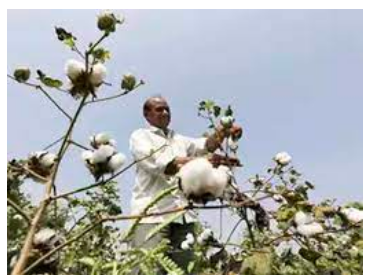Answer:
Approach:
- Introduction: Introduce the significance of cotton in India’s agricultural and industrial sectors, highlighting its multifaceted use.
- Body:
- Discuss the reasons for falling cotton production, from its importance in the textile industry and oil and feed production to economic implications for farmers and pest resistance challenges.
- Propose potential measures to address the issue, encompassing Integrated Pest Management, mating disruption, diversified crop planting, R&D for resistant varieties, farmer education, and a supportive policy framework.
- Conclusion: Conclude, reiterating the importance of a multi-pronged approach to address the decline in cotton production.
|
Introduction:
Cotton plays a pivotal role in India’s agricultural and industrial landscape. As a major textile fiber and contributor to vegetable oils and feed cake, its importance is vast. However, post-2013-14, there’s been a concerning decline in cotton production, dropping to about 343 lakh bales and 447 kg/hectare by 2022-23. This reduction has far-reaching implications for farmers and the nation’s economy.
Body:
Why India’s Falling Cotton Production is a Worry:

- Central to the Textile Industry: With cotton accounting for about two-thirds of India’s total textile fiber consumption, any decline can destabilize the textile sector, a major employer and contributor to the nation’s GDP.
- Impact on Vegetable Oil Production: Cottonseed is India’s third largest domestically-produced vegetable oil. A drop in cotton production can thus affect oil availability and prices.
- Animal Feed Production: The residual cake post-oil extraction from cottonseed is vital for livestock and poultry feed. Lower production of cotton translates to a decline in this feed source.
- Economic Implications for Farmers: Cotton provides livelihoods for millions of farmers. Falling yields can adversely impact their income, exacerbating agrarian distress.
- Resistance to Bt Toxins: As seen with the rise of the Pink Bollworm, which developed resistance to Bt proteins, there’s a risk associated with over-reliance on GM crops. The resurgence of this pest threatens yields.
Measures to Resolve the Issue:
- Integrated Pest Management (IPM): A holistic approach involving the use of bio-pesticides, natural predators, and crop rotation can help manage pest resistance and ensure sustainable cotton farming.
- Mating Disruption: Using synthesized pheromones, like Gossyplure, can disrupt the mating cycle of pests like the Pink Bollworm, reducing their population without harmful chemicals. Approaches like the PBKnot and SPLAT technologies can prove to be useful in this domain.
- Diversified Crop Planting: Encouraging farmers to grow non-Bt cotton alongside Bt varieties can reduce the likelihood of pests developing resistance.
- Research and Development: Investment in research to develop newer, more resistant GM cotton varieties and studying alternate pest control methods will be essential.
- Farmer Education and Awareness: Continuous training on best farming practices, understanding of pest life cycles, and the correct use of mating disruption techniques can prove invaluable.
- Supportive Policy Framework: Policies promoting sustainable farming, subsidies for organic and bio-pesticides, and facilitating easier access to modern pest control technologies can help combat falling yields.
Conclusion:
The declining cotton production in India is not merely an agrarian concern but resonates with broader economic and societal implications. Addressing it requires a multi-pronged approach, combining technology, sustainable farming practices, and supportive policies. The balance between immediate pest control and long-term sustainable strategies will determine the trajectory of cotton production in India.
To get PDF version, Please click on "Print PDF" button.


Latest Comments